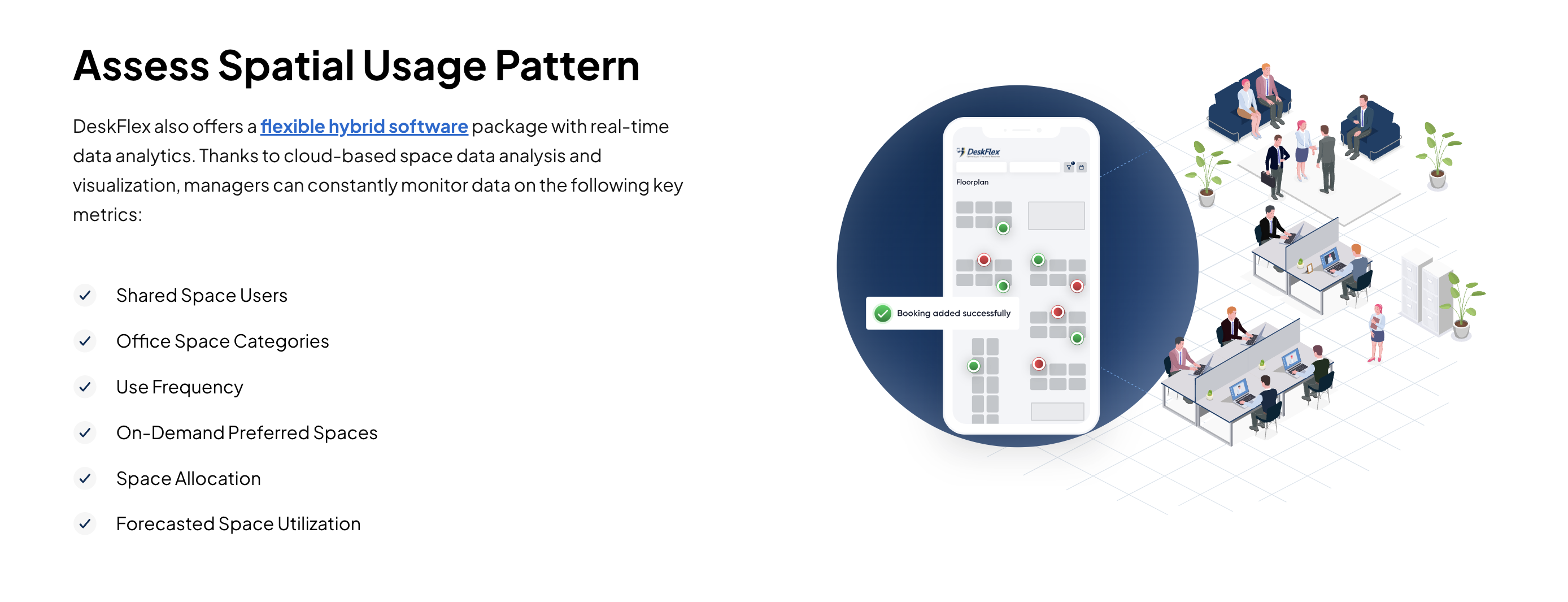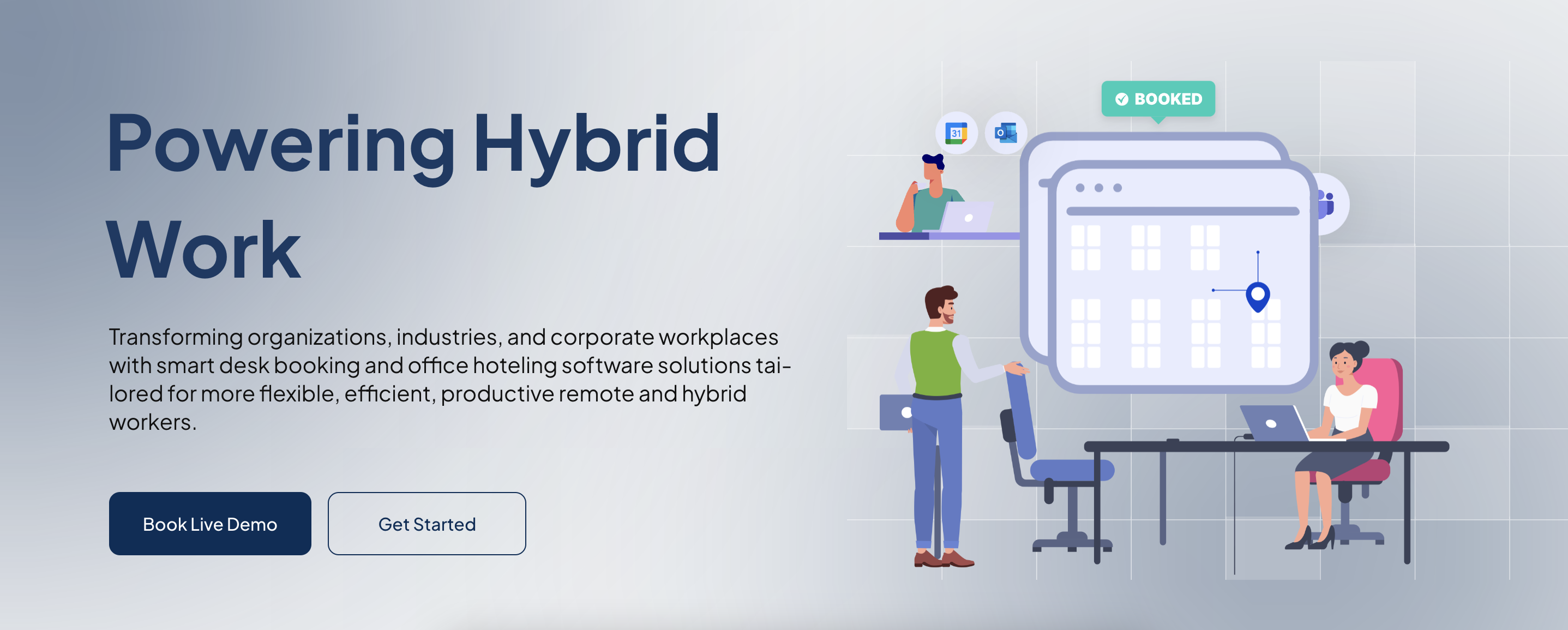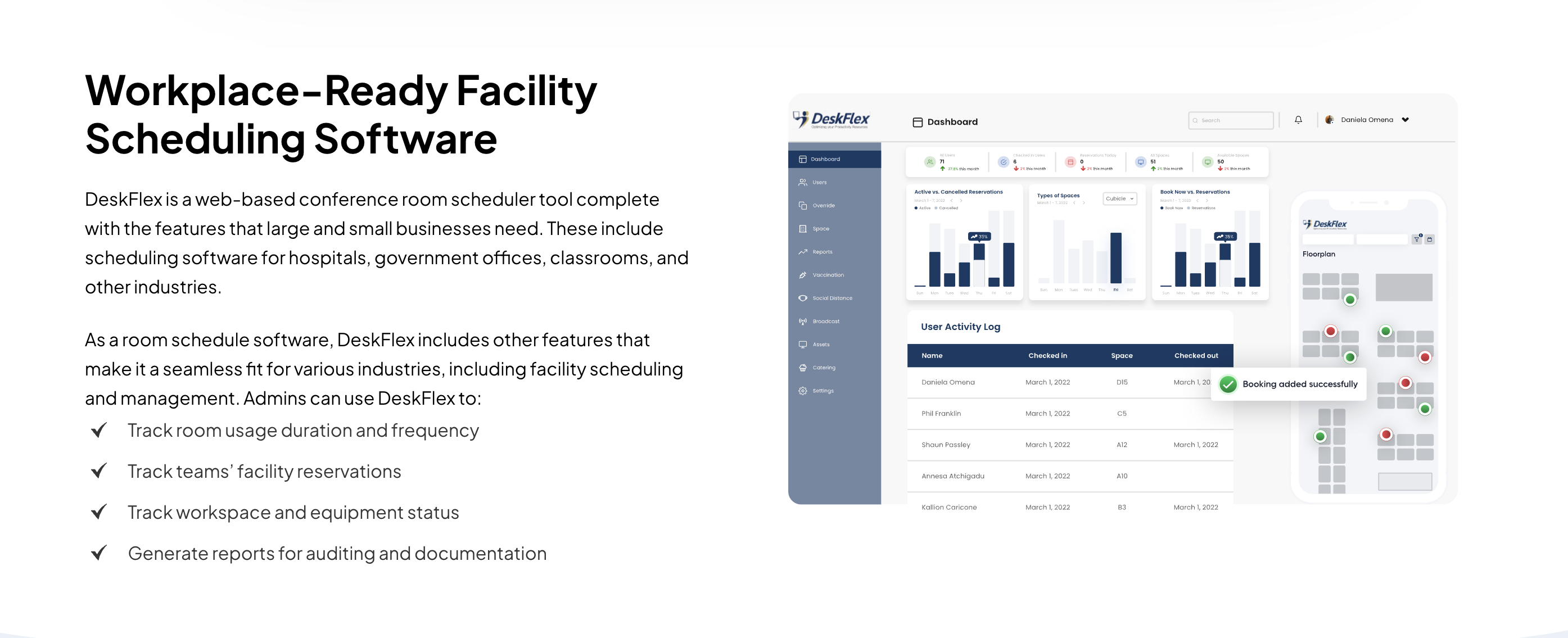Blog

How To Effectively Plan a Hybrid Work Schedule for Employees
Workplace schedules have changed dramatically, and a popular way to balance office and remote work is to adopt a hybrid work schedule.
More companies are adopting a hybrid workplace, often giving employees the flexibility to choose when they come into the office or work remotely.
Free from the restrictions of conventional workplaces, this new change improves employee satisfaction and makes the most of available office space, too.
Employees often prefer working in the office for in-person collaboration while seeking focus-intensive tasks remotely.
In this article, we’ll look at hybrid work and why it has become popular recently. We’ll also examine different types of mixed work and how managers can plan an appropriate team member’s hybrid work schedule.
What Is Hybrid Work and Why Is It the New Normal?
In a nutshell, hybrid work is a flexible work arrangement that combines both remote and on-site work. Employees can alternate between home and the office for different days when completing tasks.
By combining the best of in-office and remote work, hybrid arrangements give team members more options and flexibility.
4 Benefits of Having A Hybrid Schedule
There are many other advantages that a hybrid work schedule can offer, such as:
1. More Room for Collaboration
With a hybrid work model, organizations have more room to blend both in-office and remote work arrangements.
Key meetings, brainstorming sessions, and collaboration with cross-functional teams can take place during in-office days, while quieter, more focus-intensive tasks can be done remotely.
This balance helps employees focus on the right tasks in the appropriate work location.
2. Improved Work-Life Balance
A major advantage of having a hybrid work schedule is the improved work-life balance that comes with it.
They accommodate the needs of transformed work for employees while allowing them to offset stress and schedule non-work activities. This is especially true for employees who don’t want to experience long hours of commute for on-site work.
3. Access to Global Talent
Employers can reach out to a worldwide talent pool and grow outside of their physical office environment by establishing a hybrid workforce.
With this strategy, businesses, especially startups or those with small office spaces, can hire remote workers and, when needed, continue to have an in-office presence.
4. Reduced Turnover
The flexibility of a hybrid work model can help reduce employee turnover by enhancing employee satisfaction.
Employees who are given control over their work arrangements tend to be more engaged and less likely to seek employment elsewhere.
How to Optimize an Office Space in a Hybrid Work Model
In a hybrid work environment, businesses must rethink their office space to accommodate the blend of in-office work and remote work.
With employees working from home on some days and coming into the office on others, businesses should maximize their office space to guarantee effectiveness and employee productivity.
Flexible Seating Arrangements
With hybrid work schedules, companies can adopt flexible seating such as hot-desking, allowing employees to book desks as needed. This reduces the need for permanent workstations and maximizes space efficiency.
Collaboration Areas
Businesses can designate specific areas for different teams, brainstorming sessions, or collaborative projects. These spaces encourage in-person collaboration when employees come into the office.
By setting aside specific spaces for group activities, companies can encourage on-site collaboration when employees come into the office, improving communication, problem-solving, and the overall team dynamic–all essential for cross-functional projects and innovation.
Quiet Zones for Concentration-Heavy Work
Setting up quiet zones or private workspaces ensures that employees have areas for focused activities when most employees work in the office.
This helps balance collaborative and individual work needs.
Desk Reservation Systems
By putting in place a desk reservation system, team members can reserve workstations ahead of time, making the best use of available office space and resources.
With a desk reservation system in place, businesses can also gather data on space usage, helping them make more informed decisions about how to arrange their office for maximum efficiency and employee productivity.
Repurposing Office Space
Companies can repurpose unused or underused office areas into meeting rooms or other functional spaces, adapting to the needs of a hybrid workforce.
This adaptability allows them to meet the evolving needs of a hybrid work schedule, making sure that employees have the right kind of spaces available for different tasks, whether they need to focus, collaborate, or meet with their teams.

How Can Managers Plan a Hybrid Work Schedule for Employees?
Transitioning from a traditional work schedule to a hybrid one requires long-term planning and detailed preparation. Managers often have to include many factors when detailing hybrid arrangements.
These factors can include the type of work being done and the number of employees that need to work on-site. Other factors can include things like the overall capacity of the office building.
Regardless of the needs, it is possible to streamline the process. Be sure to follow these steps to create a compelling hybrid work schedule for employees:
Review Company Policy
First, go over the hybrid work schedule guidelines that your company has. Some organizations require core work hours or in-person attendance for specific projects.
Having a clear understanding of these requirements will assist create a schedule that works for all employees.
Other policies and expectations might extend to the following:
- Tasks that employees can complete remotely
- Minimum active hours
- Available days for remote work
List Recurring Tasks
Determine which regular tasks need to be done first. Separate tasks that require in-person collaboration from those that can be handled remotely. This way, you can assign in-office days for teamwork and remote working days for independent tasks.
Working remotely allows employees to focus on these tasks without the distractions often found in an office setting, which leads to better productivity and efficiency.
It’s important to consider the various tasks’ respective priorities. Tasks with shorter completion dates should be prioritized above those with longer timeframes.
Collaborate with Team Members
Team members should have input when creating hybrid schedules. Maintaining strong employee engagement and making sure everyone is on the same page can be achieved through having open talks.
Managers should communicate with their teams to decide the best in-office and remote days, guaranteeing successful collaboration.
Working on projects and answering questions becomes more manageable when everyone is on the same page about their schedules.
Determine Optimal Work Locations
The next step in assessing hybrid arrangements for employees is checking where they are most productive.
Doing so ensures a better hybrid schedule. It might be easier for employees to complete simple tasks in the office. Meanwhile, complex tasks requiring more focus and relaxed deadlines can be completed at home.
Consider Work-Life Balance
Professional and personal needs matter when creating optimal hybrid work arrangements.
For example, if employees are single parents, consider allowing remote work on days that ensure appropriate childcare. Strict schedules for clocking in and out also help ensure that work-related tasks are completed on time.
Note Important Events and In-Person Meetings
Hybrid work arrangements can also make room for events and in-person meetings. For the latter, managers can determine whether these meetings can be online or whether they need to be in person.
For example, scheduling other in-office tasks that day is possible if several meetings occur on the same day. Keeping all in-office functions in one day means that more time can be spent focusing on more critical tasks.
Keep Regular Schedule Updates
Finally, consider high-priority projects when creating a hybrid workplace. Unexpected assignments or meetings often result in employees needing to adjust their schedules. Switching specific on-site workdays with remote ones can better meet their needs.
Be sure to emphasize flexibility when designing a hybrid arrangement for employees. Doing so makes them more willing to adjust in case unexpected events arise.
4 Different Types of Hybrid Work Schedules Managers Can Implement
When implementing hybrid models, there’s no one-size-fits-all solution. Team leaders should mold their management style to fit its distinct character and that of their employees.
The good news is different types of hybrid arrangements can suit different needs. A hybrid work schedule can be any of the four following types:
1. Flexible
With a flexible hybrid work arrangement, employees are encouraged to complete their tasks on-site. However, they can work to arrange their schedules to choose when.
Flexible arrangements work best for small businesses with fewer than one hundred employees. Careful management and schedule planning are needed to ensure structure and office space availability.
2. Remote-First
A remote-first hybrid schedule prioritizes remote work but doesn’t necessarily eliminate on-site work.
Employees can choose their work setting, which is an excellent option for team members or businesses that operate globally. That said, managers need to plan around the downside of little to no in-person engagement.
3. Office-First
Office-first arrangements are the best way for teams needing to be physically present or need in-person collaboration.
Office-first arrangements often mean employees have limited days for remote work. While this has the downside of being the least flexible, it does work for businesses that mainly operate on-site.
4. Cohort
A cohort hybrid workplace arrangement can be a good way for companies to minimize overcrowding.
Cohort schedules allow for scheduling different departments to work on-site for specific days or alternating office work plans weekly. This work arrangement is excellent for large companies with over a hundred employees.
What to Know When Implementing a Hybrid Work Schedule
Introducing a hybrid work schedule requires careful planning and evaluation, especially for employees who used to work from the office. Here’s how to get started:
Assess Your Organization’s Needs
Start by carefully examining the workflow of each individual team, taking into account the particular requirements of every department.
Some teams, like the finance team or some administrative roles, might benefit more from in-office collaboration, while others, like creative or tech teams, may thrive on a hybrid work schedule calendar.
Take into account factors like the type of tasks each team handles, their reliance on in-office collaboration, and the tools they use to decide the most suitable hybrid work model.
Develop a Plan
Once you’ve assessed the organizational needs, create a detailed plan that outlines the hybrid work schedule, including a clear hybrid work schedule calendar. The plan should specify which days are allocated for in-office work and which are reserved for remote work.
Make sure the plan balances company objectives, such as productivity and project deadlines, with employees’ choices for a more flexible work model.
Test and Refine
Roll out the hybrid work schedule on a trial basis to see how well it functions in practice. Feedback is essential during this stage – don’t skip it!
Collaboration relies on a team-by-team basis, where team members think as one cohesive unit and work to bring their strengths to the table.
To evaluate how well the hybrid model is working, keep an eye on important measures like worker productivity, job happiness, and employee engagement.
Monitor and Evaluate
Ongoing evaluation is essential to maintaining an effective hybrid work environment. Regularly monitor how the hybrid schedule is impacting the team by conducting check-ins, surveys, or performance reviews.
These will guarantee that the hybrid work models stay in line with the business’s goals and the workforce’s requirements. They will also provide insightful information about employee experiences and opportunities for development.
How Can HR Track Employees with Hybrid Schedules?
Tracking team member hours for remote work doesn’t have to be challenging for HR departments and managers. Many tools like cloud-based scheduling and management software allow back-end users access to many features.
One such feature is real-time data analytics. Factors like performance, employee retention, and engagement are trackable and can be printed into graphs for easy understanding.
Other tools like hoteling software are also great for tracking employee hours. When implementing a hybrid workplace, alternating room and desk reservations for employees are great for optimizing limited resources.
Optimize Your Hybrid Workspace with DeskFlex

Transitioning to a hybrid work model is easier with DeskFlex’s advanced scheduling software. DeskFlex allows you to manage desks, conference rooms, and resources effortlessly.
With real-time availability tracking, employees can book their workspaces or desks through a user-friendly interface that integrates seamlessly with Microsoft Office 365 and Outlook. You will avoid double bookings, missed reservations, and streamline in-office and remote work arrangements.
Book a demo to experience a more efficient and flexible office environment.
The Bottom Line
Hybrid workplaces are here to stay for many reasons. They give employees more flexibility over their work hours while allowing companies to maximize limited resources.
However, transitioning from a traditional to a hybrid work schedule often takes long-term planning. Managers often have to consider many factors, ranging from the type of work to the number of employees.
While there is no “one-size-fits-all” solution, hybrid work arrangements can be customized for different requirements. It’s all about balancing different needs and providing the best support for employees.
FAQs About a Hybrid Work Schedule
How many days per week is hybrid work?
Hybrid work typically allows employees to split their time between working in the office and remotely. A common arrangement is three days in the office and two days working from home, but this varies depending on company policies and individual needs.
What does hybrid work mean?
Hybrid work refers to a flexible working model where employees alternate between working remotely and coming into the office. It provides a balance, allowing employees to perform tasks that require collaboration in the office and more focused, independent work at home.
Who benefits from hybrid working?
Hybrid working benefits both employees and employers. Employees enjoy a better work-life balance, reduced commuting stress, and increased flexibility, while employers benefit from higher productivity, improved employee satisfaction, and optimized office space utilization.
What is the most popular hybrid work schedule?
The most popular hybrid work schedule typically involves a “3-2 model,” where employees spend three days working in the office and two days working remotely. However, schedules can vary depending on company needs and employee roles.
What is an example of a hybrid work schedule policy?
A hybrid work schedule policy might state that employees are required to work in the office three days a week (e.g., Tuesday through Thursday) and can work remotely on Mondays and Fridays. The policy may also outline which roles qualify for hybrid work and any guidelines for scheduling in-office days.



















































 Support
Support  Demo
Demo  Blog
Blog 



